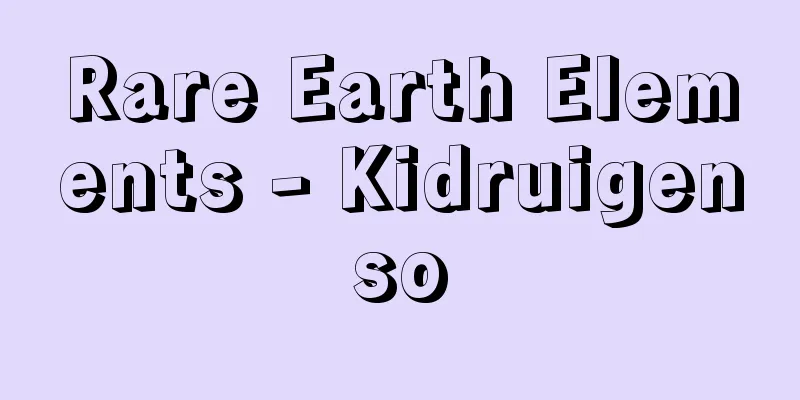Rare Earth Elements - Kidruigenso

|
[ I ] Rare earth elements: A total of 17 elements, including Sc, Y, and 15 lanthanides (La to Lu) from group 3 of the periodic table. However, actinides are sometimes included. Rare earth refers to certain metal oxides, such as magnesium oxide (MgO) and aluminium oxide (Al2O3 ) . They are called rare because they were first discovered in rare minerals, but are no longer rare. They are found naturally in the earth's crust as compounds (carbonates, phosphates, etc.), and their abundance is about the same as that of I (half that of Cl, about 7 times that of Ag), with the most abundant element being Ce, which is slightly more abundant than Cu, and the least abundant elements being Tm and Lu, which are about the same as I (half that of Cl, about 7 times that of Ag). According to Harkins' rule, elements with even atomic numbers have a higher probability of existence than the elements with odd atomic numbers on either side of them. The main ores are monazite (phosphate with a lot of Ce), bastnaesite (carbonate with a lot of Ce), and xenotime (phosphate with a lot of Y). All of these ores contain all the rare earth elements. The rare earth elements have similar properties, making it difficult to isolate them using normal chemical procedures, but currently separation is performed using ion exchange and continuous solvent extraction. The elemental metals of each element can be obtained by melting and electrolyzing the chlorides or fluorides of each element, or by reducing them with alkali metals. To produce highly pure elements, techniques such as melting in a high vacuum, distillation, and sublimation are also used. All of the elements are silvery-white metals with strong basicity. The basicity decreases with the decrease in ionic radius. They are gradually oxidized in air even at room temperature, and dissolve in acid or hot water, generating hydrogen. They do not dissolve in alkaline aqueous solutions at room temperature. They can directly react with elements such as S, Se, Te, As, B, C, and H, if the reaction conditions are selected. Among the lanthanides, Y has properties similar to Ho to Er due to lanthanide contraction. Sc also has properties similar to lanthanides (especially heavy rare earths) due to the similarity of the outer shell electron configuration. In various coordination compounds of lanthanides, the size of the central metal ion affects the coordination number and coordination type of complexes with the same ligand, but Y and Sc also tend to form complexes of the same type as elements of the corresponding size in the lanthanides. [ II ] Compounds: Rare earth elements generally have a valence of 3+. As an exception, Ce can have a valence of 4+, while Sm, Eu, and Yb can have a valence of 2+. Sc3 + , Y3 + , La3 + , Ce4 + , Lu3 + , and Yb2 + are diamagnetic, while the rest are paramagnetic. Rare earth 3+ ions are stable, and the size of the ions is similar to that of alkali metals and alkaline earth metals, so they easily form complex oxides such as perovskite-type structures, some of which exhibit peculiarities due to lattice defects. They also exhibit magnetic and optical peculiarities due to the incomplete filling of the 4f orbitals, and these are utilized in many applications. Of the salts, salts such as Cl - , Br - , I - , NO 3 - and ClO 4 - are soluble in water, while salts such as F - , CO 3 2- , PO 4 3- and (COO) 2 2- are insoluble in water. Salts of SO 4 2- are also not very soluble, but the solubility decreases from La to Eu, and then increases thereafter. During the production of rare earth salts, the rare earths are precipitated and separated from other metal salts, taking advantage of the fact that oxalates are poorly soluble in water, and these are then heated and decomposed to form the oxides, which are then dissolved in various acids to produce the respective salts. Of the rare earth salts, the following are colored due to the influence of 4f electrons, but all others are colorless. Rare earth elements form complexes with many ligands, including citric acid and EDTA. The coordination number of complexes is often 6 for Sc, but 7 or more is common for Y and the lanthanides (7, 8, and 9 are common, but sometimes even more). [ III ] Uses: (1) Alloys: Pyrophoric alloys (Ce-Fe, La-Mg), permanent magnet alloys (SmCo 3 , Nd-Fe(+Co)-B alloys, etc.), hydrogen storage alloys (LaNi 5 , CeNi 5 ), and alloy films for recording layers of magneto-optical disks (Gd, Tb, Dy-Fe, Co alloys). (2) Oxides: CeO 2 or light rare earth misch metal oxides are used for polishing glass and other materials. Mixed oxides include high-temperature superconductors (for example, the copper oxide YBa 2 Cu 3 O 7- δ ). Mixed oxides of rare earths are also used as electrolytes and electrode materials for fuel cells. (3) Nuclear power: Gd has the highest neutron capture ability of all the elements (followed by Eu and Dy), so it is used for emergency control of nuclear reactors. Dy(+Gd)-Pb alloys are also used as radiation shielding materials, and Y is used as a moderator in nuclear reactors. (4) Ceramics, etc.: (a) Special glass; La-added glass has a high refractive index and low dispersion and is used for lenses, while Nd-added glass is used for spectacles and window glass to avoid glare. It is also added to colored glass (Ce → yellow, Pr → yellow-green, Nd → reddish purple to blue, Er → pink, etc.). (b) Industrial materials; sintered zirconia (Y 2 O 3 -ZrO 2 ) is very hard and is processed into blades, tools, etc., for use. Zeolite-substituted catalysts are also used in petroleum cracking. (c) Garnet-type electronic materials: Various types are produced, including YIG (Y 3 Fe 5 O 12 ), YAG (Y 3 Al 5 O 12 ), and GGG (Gd 3 Ga 5 O 12 ). YIG and GGG are used as magnetic bubble memory materials, while YAG, doped with a few percent of Nd, is used as a high-power laser light source with a wavelength of 1.06 μm. It is also used in laser nuclear fusion and surgical lasers. These are also used as electronic materials for capacitors, varistors, dielectric elements, and other devices. YAG and GGG are also used as artificial gemstones, as they are hard and have a large refractive index. (d) Optical fibers: Glass doped with Er and other elements, especially fluoride glass, is used and is being researched. (e) Sensors: F - ion sensors that use single crystal films of LaF 3 are used. (f) Phosphors: There are various phosphors for television cathode ray tubes, including Y 2 O 2 S (plus a few percent Eu) for the red color. Phosphors for colored fluorescent lamps include those that contain La, Ce, Tb for green, and Eu 2+ for blue, in addition to the red. For medical purposes, (Y,Gd) 2 O 2 S (plus a few percent of Eu, Pr) is used for X-ray scintillators to improve the X-ray measurement sensitivity of CT scans. La 2 O 2 S (plus a small amount of Tb) is coated on film for direct X-ray photography as a sensitizer. Source: Morikita Publishing "Chemical Dictionary (2nd Edition)" Information about the Chemical Dictionary 2nd Edition |
|
【Ⅰ】希土類元素:周期表3族のSc,Y,およびランタノイド(La~Lu)15元素の合計17元素のこと.ただし,アクチニドも含めることもある.土とは,苦土MgO,ばん土Al2O3など,ある種の金属酸化物のこと.希は,最初に発見されたのが珍しい鉱物中であったためであるが,現在では希ではない.天然には,地殻中に化合物(炭酸塩,リン酸塩など)として広く存在し,その存在度は,一番多いCeはCuよりやや多い程度,一番少ないTmやLuでもI程度(Clの半分,Agの7倍程度)である.なお,ハーキンズの規則により,原子番号が偶数の元素は,両隣りの奇数番号の元素より存在確率は大きいことが認められる.おもな鉱石は,モナズ石(リン酸塩でCe族が多い),バストネス石(炭酸塩で,Ce族が多い),ゼノタイム(リン酸塩で,Y族が多い)である.これらの鉱石はいずれも全希土類を含んでいる.希土類元素は相互の性質が類似していて,通常の化学操作では単離が困難であったが,現在,分離はイオン交換法や連続溶媒抽出法などにより行われている.各元素の単体金属は,各元素の塩化物やフッ化物の溶融電解,またはアルカリ金属による還元などで得られる.とくに高純度なものの製造には,高度の真空中での溶融,蒸留,昇華などの手法も用いられる.いずれも元素単体は銀白色の金属で,塩基性が強い.塩基性はイオン半径の減少とともに減少する.空気中では常温でも徐々に酸化され,酸や熱水には水素を発生して溶ける.室温でアルカリ水溶液には溶けない.S,Se,Te,As,B,C,Hなどの単体とは,反応条件を選べば,いずれも直接に反応する.ランタノイドでは,ランタノイド収縮のため,YはHo~Erに性質が似る.Scは外殻電子配置の類似からやはり性質がランタノイド(ことに重希土)に似る.ランタノイドの種々の配位化合物では,中心となる金属イオンの大きさが,同じ配位子による錯体の配位数や配位型に影響するが,Y,Scもランタノイドの相当する大きさの元素と同型の錯体をつくる傾向がある. 【Ⅱ】化合物:希土類元素は,一般に3+の原子価をとる.例外として,Ceは4+,Sm,Eu,Ybは2+となりうる.磁性は,Sc3+,Y3+,La3+,Ce4+,Lu3+,Yb2+ は反磁性,それ以外は常磁性である.希土類の3+価イオンは安定で,イオンの大きさもアルカリ金属やアルカリ土類金属のイオンと類似しているため,ペロブスカイト型構造のような複合酸化物を容易に形成し,それらのなかには格子欠陥に伴う特異性を示すものがある.また,4f軌道が不完全に充填されていることによる磁気的,光学的な特異性を示し,それらを利用した用途が多い.塩のうち,Cl-,Br-,I-,NO3-,ClO4-などの塩は水に可溶,F-,CO32-,PO43-,(COO)22- などの塩は水に不溶.SO42-の塩もあまり溶けないが,溶解度はLa→Euでは順次減少し,それ以後は順次増加する.希土類の塩の製造の途中,シュウ酸塩が水に難溶なことを利用して,希土類をほかの金属塩などから沈殿分離し,次にこれを加熱分解して酸化物とした後に,各種の酸に溶解してそれぞれの塩をつくることがある.希土類の塩のうちで,次のものは4f電子の影響で着色しているが,それ以外は無色である. 希土類元素はクエン酸,EDTAをはじめ,多くの配位子と錯体をつくる.錯体の配位数は,Scでは6をとることが多いが,Yおよびランタノイドでは7以上が普通である(7,8,9が多いが,それ以上のこともある).【Ⅲ】用途:(1)合金:発火合金(Ce-Fe,La-Mg),永久磁石用合金(SmCo3,Nd-Fe(+Co)-B系合金など),水素吸蔵合金(LaNi5,CeNi5),光磁気ディスクの記録層用合金膜(Gd,Tb,Dy-Fe,Co系合金)などがある.(2)酸化物:CeO2または軽希土のミッシュメタル酸化物は,ガラスなどの研磨に用いられる.混合酸化物には高温超伝導体(たとえば,銅酸化物系のYBa2Cu3O7-δ)がある.また,希土類の混合酸化物は,燃料電池の電解質や電極物質にも用いられる.(3)原子力関連:Gdは元素中で中性子捕獲能力が最大である(Eu,Dyがこれにつぐ)から,原子炉の緊急制御用に用いられる.また,Dy(+Gd)-Pb合金は放射線しゃへい用材に,Yは原子炉の減速材に用いられる.(4)セラミックスなど:(a)特殊ガラス;La添加ガラスは高屈折,低分散でレンズ用,Nd添加ガラスはまぶしさを避ける眼鏡,窓ガラスなどに用いられる.また,色ガラス用に添加される(Ce→黄,Pr→黄緑,Nd→赤紫~青,Er→桃など).(b)工業材;焼結ジルコニア(Y2O3-ZrO2)は硬度大で,刃物,工具などに加工して利用される.また,ゼオライト置換型などの触媒は石油クラッキングに利用される.(c)ガーネット型電子材料;YIG(Y3Fe5O12),YAG(Y3Al5O12),GGG(Gd3Ga5O12)など各種のものがつくられている.YIGやGGGは,磁気バブルメモリー材に,YAGは,Ndを数% ドープしたものが,波長1.06 μm の大出力レーザー光源用に用いられる.また,レーザー核融合用や,手術用レーザーにも利用される.さらに,これらは,コンデンサー,バリスター,誘電体素子などの電子材料にも用いられる.また,YAGやGGGは,硬く屈折率も大きいので人造宝石としても用いられる.(d)光ファイバー;Erなどをドープしたガラス,とくにフッ化物ガラスが利用され,研究されている.(e)センサー;LaF3の単結晶膜を利用する F- イオンセンサーなどが利用されている.(f)蛍光体;テレビのブラウン管用の蛍光体として,赤色用のY2O2S(+Eu数%)をはじめ,いろいろのものがある.着色蛍光灯用の蛍光体には,赤色用以外にLa,Ce,Tb→緑,Eu2+→青などを加えたものが利用される.医療用には,CTのX線測定感度向上のため,X線シンチレーター用に,(Y,Gd)2O2S(+数% のEu,Pr)を用いる.直接X線撮影用フィルムに増感剤として,La2O2S(+少量のTb)を塗布する. 出典 森北出版「化学辞典(第2版)」化学辞典 第2版について 情報 |
<<: Rare earth permanent magnet - Kidorui Cobalt Magnet
>>: Guitry and his son - Guitry
Recommend
Spanish iris (English spelling)
…In horticulture, irises are broadly divided into...
Batcher Plant
Batcher plant is a large-capacity concrete mixing ...
Gorgonocephalidae
…A general term for echinoderms belonging to the ...
Élizabeth Vigée‐Lebrun
1755‐1842 A French female painter. Vigée was her f...
Kennaway, E.
…But in 1915, Japanese scientists Katsusaburo Yam...
American Dipper - American Dipper
…It is found in East Asia east of the Himalayas, ...
Karigane Junichi
1879-1959 A Go player from the Meiji to Showa era...
Girikugai - Girikugai
...In particular, in many places, visiting or att...
Kumazasa - Kumazasa
A type of bamboo or bamboo grass of the grass fam...
Cor Caroli
Alpha 2 of Canes Venatici. Its unusual Latin name,...
Short song (short song) - Kota
A short Japanese folk song. It is also written as ...
Battle of Ejima
…In the early days of the Northern and Southern C...
Information industry paper - Information industry paper
A general term for paper used as an information in...
Mizusawa [city] - Mizusawa
An old city in southern Iwate Prefecture. Establis...
Hansanseong Fortress
… [Second Period: Era of Federation of Lords and ...









